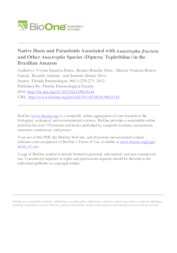Native hosts and parasitoids associated with Anastrepha fractura and other Anastrepha Species (Diptera: Tephritidae) in the Brazilian Amazon.
Native hosts and parasitoids associated with Anastrepha fractura and other Anastrepha Species (Diptera: Tephritidae) in the Brazilian Amazon.
Autoria: DUTRA, V. S.; RONCHI-TELES, B.; GARCIA, M. V. B.; ADAIME, R.; SILVA, J. G.
Resumo: The Brazilian Amazon region comprises an exceptionally high diversity of angiosperms, among which approximately 180 described species, both native and exotic that can be potential fruit fly hosts (Silva & Ronchi-Teles 2000). Currently, 60 Anastrepha species have been recorded in the Brazilian Amazon region, of which about 30 species are endemic (Trindade & Uchôa 2011; Zucchi et al. 2011). Here we report on new host/fruit fly/parasitoid associations for some Anastrepha species for both Brazil and the Amazon region. A total of 4,137 fruit (73.9 kg) from 40 different native and introduced plant species in 19 families were collected from 2008 through 2011 in Manaus (S 03° 06' 07" W 60° 01' 30"), Maués (S 03° 23' 01" W 57° 43' 07"), Presidente Figueiredo (S 02° 02' 04" W 60° 01' 30"), and São Gabriel da Cachoeira (S 00° 07' 49" W 7° 05' 21") in the state of Amazonas; in Porto Velho (S 08° 45' 43" W 63° 54' 14") in the state of Rondônia, and in Boa Vista (S 02° 49' 11" W 60° 40' 24") in the state of Roraima. Fallen fruit, both ripe and ripening, were collected randomly from the ground under tree canopies within the forest. Cassava fruits were collected in an area adjacent to the forest in Manaus (Amazonas) and Porto Velho (Rondônia). Adult flies and parasitoids were reared from collected fruits following methods described in Ronchi-Teles et al. (2011). Voucher specimens were deposited at the Coleção de Invertebrados of the Instituto Nacional de Pesquisas da Amazônia. A total of 3,470 fruit (63.3 kg) were infested yielding 7,662 puparia from which 3,073 Anastrepha adults (1,469 males and 1,604 females), 669 braconid parasitoids, and 17 figitid parasitoids emerged. We report Anastrepha fractura Stone infesting fruit of Salacia sp. (Celastrales: Celastraceae) in association with Asobara anastrephae (Muesebeck), Doryctobracon brasiliensis (Szépligeti), and Opius bellus Gahan parasitoids for the first time (Table 1). Previously, A. fractura had been reported solely from Guyana (Stone 1942) and Amazonas, and the only known host and associated parasitoid were Maquira sclerophylla (Ducke) C.C. Berg (Rosales: Moraceae) and Doryctobracon areolatus (Szépligeti) (Costa et al. 2009), respectively. We also report Anastrepha distincta Greene infesting Inga cinnamomea Spruce ex Benth (Fabales: Fabaceae: Mimosoideae) in Brazil for the first time (Table 1), but which was not attacked by any of the parasitoid species herein reported. The remaining 13 Anastrepha species recovered during sampling (Table 1) had previously been reported infesting the hosts from which they were recovered here (Zucchi et al. 2011).
Ano de publicação: 2013
Tipo de publicação: Artigo de periódico
Unidade: Embrapa Amazônia Ocidental
Palavras-chave: Hospedeiro, Parasitoides
Observações
1 - Por padrão são exibidas publicações dos últimos 20 anos. Para encontrar publicações mais antigas, configure o filtro ano de publicação, colocando o ano a partir do qual você deseja encontrar publicações. O filtro está na coluna da esquerda na busca acima.
2 - Para ler algumas publicações da Embrapa (apenas as que estão em formato ePub), é necessário ter, no celular ou computador, um desses softwares gratuitos. Sistemas Android: Google Play Livros; IOS: iBooks; Windows e Linux: software Calibre.
Acesse outras publicações
Acesse a Base de Dados da Pesquisa Agropecuária (BDPA) para consultar o acervo completo das bibliotecas da Embrapa.

